 |
 |
窯垣の小径、本業窯、陶祖公園、宝泉寺 |
| 2001年10月6日(土)陶祖公園、窯垣の小径資料館及び宝泉寺へ行きました。 I have visited 'Toso Park', 'Kamagaki-no-komichi museum' and 'Hosenji Temple' on Oct. 6, 2001. |
| 窯垣の小径の駐車場 の北側壁面 Parking lot of Kamagaki- no-komichi |
陶祖公園(注1) Toso Park (Note 1) |
志野焼灯籠(注1) Lantern made by pottery (Note 1) |
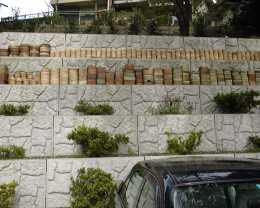 |
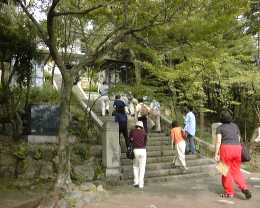 |
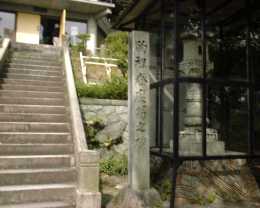 |
| 陶祖碑(注1) Monument in honor of Toshro Kato, founder of Seto pottery (Note 1) |
ムクノキ(注3) deciduous tall tree (Note 3) |
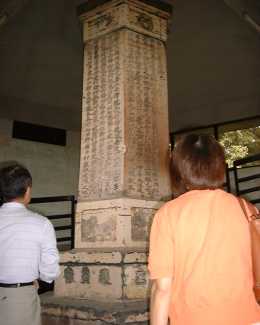 |
 |
| 鬼板 Clay with iron oxide |
窯垣(注5) (Note 5) Fence made of tools for pottery |
窯垣の小径資料館 Kamagaki-no-komichi museum |
 |
 |
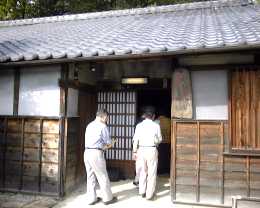 |
| 窯道具(注5) Tools for pottery (Note 5) |
本業タイル(注7) Hongyo tile (Note 7) |
本業タイルの源流(左と 江戸末期の敷瓦(右) (注7と8) Origin of Hongyo tile (left); Shikigawara roofing tile(right) (Note 7 and 8) |
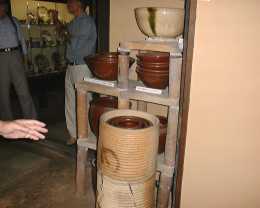 |
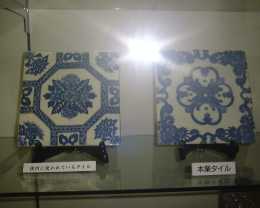 |
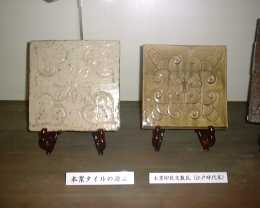 |
| 注1 陶祖公園 陶祖の加藤藤四朗(注2)の偉業を称える六角陶碑である陶祖碑が祭ってあります。 この陶祖碑は慶応3年(1867年)に完成した高さ約4m、六角の各面の幅約60cmで 大小30個の陶器から成っています。 高さ285cmの志野焼燈篭は陶製燈篭としては 国内最大級の大きさで瀬戸市の有形文化財として指定。 約1年の歳月をかけて焼き上げ 完成。陶祖碑の前方下段に左右一対が明治5年(1872年)3月設置されました。 注2 陶祖藤四朗 鎌倉時代に僧道元に従い、宋(中国)に渡り、陶業技法を学び、帰国。 瀬戸で良質の 陶土を発見し、瀬戸で窯を開き瀬戸陶業の発展の礎を築いたとされている人物。 毎年4月の第3土曜と日曜には藤四朗を偲び’陶祖まつり’が催されます。 注3 ムクノキ(椋の木:ニレ科)(洞街道の立て看板の説明より) 山野にはえる落葉高木。材は折れにくく、また割れにくい為、陶磁器製品を運ぶための 天秤棒として利用される。 このムクノキをたずねて歩くと、その付近に必ずといって よいほど古窯があったとされる。また、いまなお窯を操業しているところもあり、ムクノキを 線で結ぶことによって、今昔にわたる洞の窯場密集地域を知ることが出来ると推定。 注4 宝泉寺 (曹洞宗大唱山) 宝泉寺は約720年前、霊水山神宮寺として創立。正保4年、雲興寺15世興南和尚により 曹洞宗の禅刹大晶山宝泉寺が開かれました。当時の本尊は延命地蔵菩薩像で あったという。 その後、昭和9年、諸堂が一新され、本尊が現在の釈迦牟尼仏に改め られました。 曹洞宗は鎌倉時代の高僧、永平道元禅師によって大陸よりもたらされました。 宝泉寺は瀬戸市内の古瀬戸、洞、祖母懐に通じる陶都瀬戸の要衝でもあり、今でも 宝泉寺周辺には窯垣に囲まれた家並みが多く残っています。 毎年11月8・12日には 薬師如来の縁日が催され’お薬師さん’と呼ばれ、地元の方をはじめ多くの参詣客で 賑わいます。 古来よりの作陶の歴史を物語る由緒正しき地に宝泉寺は静かに佇ん でいます。 (注の出典:’窯垣の小径資料館’’宝泉禅寺’のパンフレット他) Note 1 Toso
Park [source]
Pamphlets or brochures of 'Kamagaki-no-komichi museum' , |